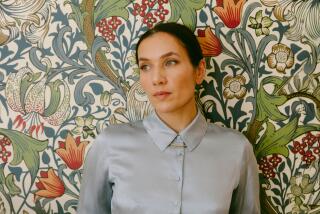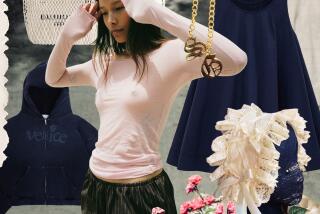GIRL: YOU’RE A WOMAN NOW : Look of Innocence Appeals to Some, While Others Think It’s Childish.
- Share via
Baby-doll dresses, pleated plaid miniskirts and black patent leather Mary Janes--such girlish styles ordinarily wouldn’t raise an eyebrow, except that this season one can find them in the women’s department.
The ingenue look has women dressing up like little girls in youthful styles such as short, A-line dresses with Peter Pan collars and empire waists that conceal womanly figures.
Some say the look is just innocent fashion fun, a feminine alternative to power suits and killer shoulder pads. Others view girlish styles as a dangerous trend. They claim the look demeans and infantilizes women, making them appear like naive girls who need taking care of instead of competent working women.
“Why would grown women want to look like little girls?” asks Lois Banner, author of the book “American Beauty” and a professor at USC who specializes in fashion and feminism.
“These fashions infantilize women. It’s a reaction to women in the workplace and to powerful women,” Banner says. “It’s an attempt to contain women . . . to react to the feminist movement from a negative point of view.”
Holly Sharp, fashion designer and owner of the Holly Sharp Signature Boutique in Corona del Mar, who has made ingenue dresses one of her trademark looks for fall, disputes the idea that these styles are anything more than playful fashion.
“That’s totally ridiculous to think that any dress can disempower anybody,” she says. “Your power and intelligence come from a much deeper place than anything you wear.”
Sharp says it’s confidence that is making women unafraid to flaunt their femininity and don Lolita looks.
“There’s a difference between being feminine and infantile. A woman who dresses this way is not being a victim; she’s just showing her femininity. The confidence is there,” Sharp says.
The ingenue look has become a huge trend, she says, starting a couple of years ago when baby-doll dresses went mainstream.
“ Cute used to be a nasty word,” she says. “Five years ago I would never have done anything in pink or baby blue, but those colors are really popular. . . . It’s confidence. We feel better about our femininity.”
Among her current ingenue looks are plaid jumpers and short dresses with A-line silhouettes, such as her black crepe cocktail dress with an empire waist, white Peter Pan collar and tiny pearl buttons ($110).
“Baby buttons and Peter Pan collars are details that are taken from little girls’ dresses,” Sharp says. “From a design standpoint, it just works on small dresses to use tinier trims and details.”
She creates such styles with an under-35 customer in mind.
“It doesn’t really work if you’re in your 40s,” she says.
She also doesn’t envision her ingenue dresses, short plaid skirts and baby T-shirts in the workplace.
“We don’t intend these for the office,” says Sharp, holding up a plaid miniskirt. “That doesn’t work unless you’re Heather Locklear.”
Image consultants who counsel clients about what to wear to work agree that girlish fashions don’t belong at work.
“You’re emphasizing your innocence, your naivete and childlike qualities. That’s not how you want to be perceived at the office,” says Sandi Clark, co-owner of Image Works, an image-consulting firm in Irvine.
“It’s real hard to be taken seriously when you’re wearing a baby-doll look.”
Still, Clark is not above wearing a baby-doll dress herself if she’s headed for a night on the town.
“It’s a matter of appropriateness. You have to ask, ‘What type of person will I attract to me if I wear this?’ If you want to look like you want to be taken care of, maybe it’s not a bad idea. But in the workplace, it puts women at a definite disadvantage. It looks playful and vulnerable. We’ve worked too hard to overcome these perceptions.”
She worries that young women out of high school or college who don’t have large clothing budgets will wear their girlish party clothes to work to stretch their fashion dollars.
“A woman in her 20s often wants to spend her money on fun, sexy things. She tries to wear these to work and then gets upset with how she’s treated,” Clark says.
For after-hours and weekends, though, feminine dresses are a welcome break from conservative business attire, says Wakim Kirvorkian, owner of the Michael Nusskern women’s clothing boutique in Fullerton. His boutique has a variety of little slip and baby-doll dresses, many fitted to the bust with flowing skirts.
“I personally like the look. It’s fun and young and very up,” Kirvorkian says. “Women want anything soft and pretty. They’re tired of putting on a trouser or skirt, a blouse and a belt. It’s nice for them to slip on a dress and be done.”
Banner sees a different motive behind the popularity of baby-doll dresses. She speculates that girlish looks are popular with younger women now because of their deep-seated desire to be free of adult responsibilities.
“Young women are very frightened,” she says. “They know they’re supposed to go out into the work force, and yet jobs are very scarce right now. This could be a response to that. They don’t want to grow up.”
Heathyr Lawrence, owner and designer of the young women’s line Mantrap, in Costa Mesa, disagrees: “It’s just a look and has nothing to do with insecurity and wanting to be taken care of. I’ve never thought of it like that. We don’t have to dress in a suit to feel powerful. I don’t think there’s some deep secret to it. It’s just a fad.”






